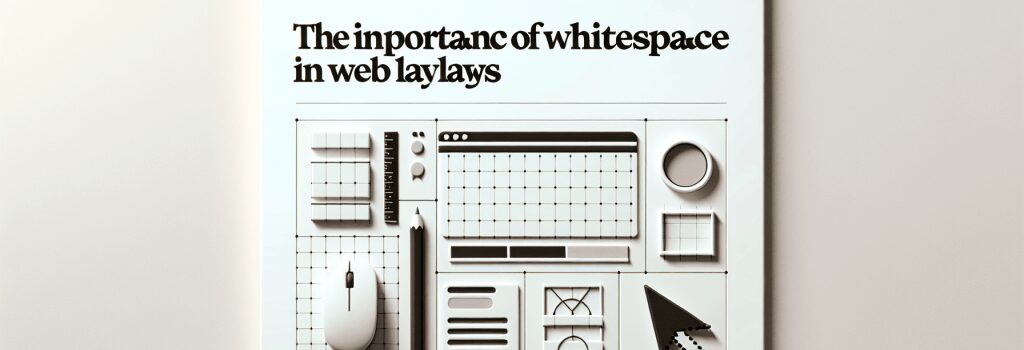The Importance of Whitespace in Web Layouts

Welcome, dear future webologists, to another chapter in the thrilling saga of your coding adventure! Hold onto your keyboards, snug up that mouse, and maybe, if you’re feeling exceptionally daring, pop open a caffeinated beverage. This one gets good.
So, you’re probably thinking, “Whitespace? Seriously? You’re going to make me read about…nothing?” Well, yes and no. Whitespace might seem like a comical non-character in our web development narrative, but we promise — it’s more important than you think!
The Silent Hero in Your Web Design
Consider for a moment, your favorite scenic view. Now, imagine that view was cluttered with billboards, litter, or dare we say, pop-up advertisements! It’s the same with your web layout. Whitespace, dear coders, is your serene, calming, clutter-free mountain view. Whitespace gives your users a breath of fresh air. Much like that refreshing Alpine breeze, it clears their minds and allows them to focus on what’s important.Improving Readability and Navigability
Now, picture your favorite book. Every line, every word, squashed together with no space or margin. It’d be like trying to read the mind of a caffeinated squirrel! That’s a big “no thanks” for most users. This is where our unsung hero, whitespace, steps in! By creating buffer zones between text, graphics, and other elements, whitespace increases readability and improves user navigation.Framing Your Content
Imagine you’ve painted a marvelous masterpiece, worthy of hanging in the Louvre. Would you leave it to raw elements, or would you opt for a nice white mat to frame it before encasing it in glass? Whitespace in website layouts is like the mat around a painting. It provides a visual break that allows the user to focus on the content, highlighting the important parts and improving overall user experience.The Science of Whitespace
Ah, yes. All of you left-brained folks were wondering if we’d get to the good stuff, right? More and more studies are showing that websites with well-thought-out use of whitespace increase comprehension by up to 20%. That’s like going from a “C” to an “A” just by adding a little space!Building Visual Hierarchy
Remember back in elementary school when your teacher would yell “SPACE!” and huge gaps would open up in the line to the cafeteria as everyone literally stepped back? That’s kind of how visual hierarchy works. Whitespace can be used to separate different types and levels of information, helping users understand what to pay attention to first, second, and so on.Alright codesters! As you sail forth into the wild seas of web development, always remember the importance of good old whitespace. Enjoy the calm, clear waters it brings and remember: in the digital universe, sometimes less really is more!
FAQ
What is whitespace in web layouts?
Whitespace, also known as negative space, is the empty space between text, images, buttons, and other elements on a web page.
Why is whitespace important in web design?
Whitespace helps to improve readability, organization, and user experience on a website by creating visual hierarchy and separating content.
How does whitespace affect user engagement?
Whitespace can increase user engagement by reducing cognitive overload, making it easier for visitors to focus on the important elements of a web page.
Does whitespace impact website performance?
Contrary to what some may think, whitespace does not directly impact website performance, but it can enhance overall user satisfaction and perception of the site’s quality.
How can I incorporate whitespace into my web layouts effectively?
You can use generous margins, padding, line spacing, and paragraph breaks to create breathing room around elements and help guide the user’s eye.
Can whitespace be used strategically in responsive web design?
Yes, properly utilizing whitespace in responsive design can help maintain a clean and consistent layout across different screen sizes, improving the overall user experience.
What are some examples of websites that use whitespace effectively?
Websites like Apple, Airbnb, and Medium are known for their sophisticated use of whitespace to create visually appealing and user-friendly interfaces.
Is there such a thing as too much whitespace on a web page?
Yes, excessive whitespace can make a website appear overly sparse and may lead to content being pushed too far apart, negatively impacting the visual flow of the page.
How can I convey the importance of whitespace to clients or colleagues?
You can showcase before-and-after examples of your designs with and without proper whitespace to demonstrate the impact on readability and overall aesthetics.
Are there any tools or resources to help optimize whitespace in web layouts?
Tools like Adobe XD, Sketch, and Figma offer features that allow designers to easily adjust and visualize whitespace, helping to create balanced and effective web layouts.
Categories


